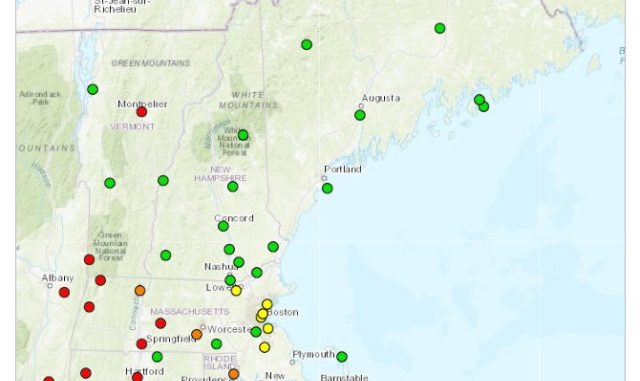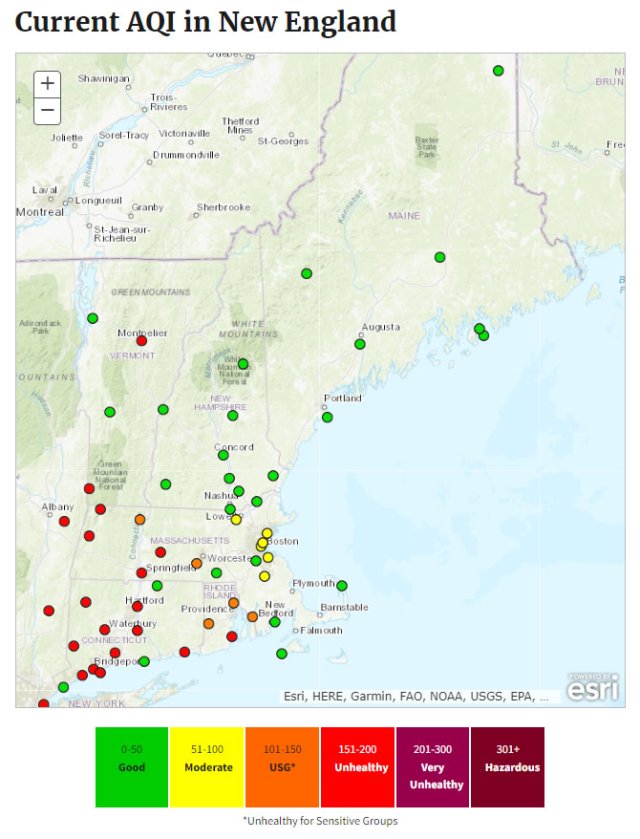
BOSTON – Smoke from wildfires in Quebec and Northern Ontario is continuing to cause elevated levels of air pollution in many portions of New England. The primary concern is high concentrations of fine particle air pollution that is unhealthy, especially for sensitive groups such as people with respiratory disease, the elderly, or people with compromised health.
Areas that are currently exceeding the Federal air quality standard for 24-hour particle pollution level concentrations are:
Connecticut, Western Massachusetts, Rhode Island, and portions of Vermont
“Many areas in New England are currently experiencing unhealthy air quality levels due to smoke from wildfires in Canada. Scientists predict that the fire season in Canada will be longer and more intense as a result of climate change, so there is a chance we will see more of these kinds of events,” said EPA New England Regional Administrator David W. Cash. “We are seeing levels of air pollution that are unhealthy for all people, and especially for sensitive populations. EPA encourages people to check their Air Quality Index (AQI) throughout the day to be aware of their local air quality and take steps to reduce smoke exposure and protect their health. Pay attention to any health symptoms if you have asthma, COPD, heart disease, or are pregnant. Get medical help if you need it.”
Smoke can cause air quality to change rapidly. Stay up to date on current air quality and forecasts near you through the AirNow app, available for free on the Apple App Store and Google Play Store. You also can use the app to check the AirNow Fire and Smoke Map. EPA and the U.S. Forest Service developed the map to give the public information on fire locations, smoke plumes, near real-time air quality and actions to take to protect your health — all in one place. The map is available at https://fire.airnow.gov, or by tapping the Smoke icon in the AirNow app. It includes data from hundreds of air quality monitors provided by state and local air quality agencies, along with crowd-sourced data from air quality sensors.
Most healthy adults and children will recover quickly from smoke exposure and will not have long-lasting health effects. But people with chronic diseases, such as asthma, other lung disease, or cardiovascular disease are at greater risk of experiencing more severe health effects. Children, pregnant people, and people over 65 also are more vulnerable to health effects from smoke exposure Limit your outdoor exercise when it is smoky or choose lower-intensity activities to reduce your smoke exposure. When indoors, take steps to keep your indoor air cool and clean. For more tips, see https://www.airnow.gov/wildfires/when-smoke-is-in-the-air/
Larger and more intense wildfires are creating the potential for greater smoke production and chronic exposures in the U.S., particularly in the West. Wildfires increase air pollution in surrounding areas and can affect regional air quality. If you must be outdoors when wildfire smoke is in the air, an N-95 mask can help reduce the smoke you breathe in and potential health risks.
State, local, and tribal governments work closely with EPA, the Forest Service, and other departments to maintain a strong monitoring network to help inform the public about local air quality conditions and what steps to take to protect themselves from air pollution and wildfire smoke. This partnership is what makes AirNow.gov work.
More information and Resources:
Real-time ozone data and air quality forecasts New England Air Quality Index
National real-time air quality data (free iPhone and Android apps) AirNow
Air Quality Alerts EnviroFlash

